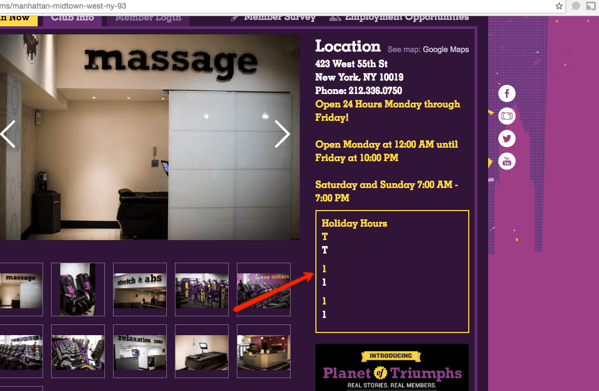For distributed brand managers, these creative "assets" make you laugh – when they're not your brand – and make you cry when one of your local outlets is the perpetrator.
Awkward end cap displays and misspelled, handwritten signs make for prime online entertainment, but certainly aren't funny when it's your organization projecting a sloppy image with slapdash signs.
As a distributed brand manager, bad in-store signage is one of your biggest fears. Time and time again, research shows that in-store packaging and signage shape a customer's perception of your entire brand. Unauthorized, customized images, like the ones shown below, don't reflect well on your organization.
Perhaps more importantly, bad local marketing execution may be a clear sign that your brand's marketing management is falling apart. Join us, as we review some of the most cringe-worthy images of local marketing gone wrong.
6 Cringe-Inducing Signs Your Distributed Brand is Falling Apart
1. Local Outlets Attempt a Microsoft Word Design
Your local marketers need signs quickly, and often with short notice. In the case pictured here, the local store may have been following directions from headquarters to post information about a product recall. Unfortunately, the resulting sign is text-heavy, difficult to read, and almost definitely designed in Microsoft Word:
2. Your Local Marketing isn't Customized at All
In most cases, brand designers can't do everything for everyone - especially when it comes to short-notice requests for quick turn-around on assets. Some amount of customization is to be expected. If local marketers lack the right resources or skills, sometimes the customization doesn't happen.
For local marketers with minimal design skills, or a lack of desire to spend money on professional design, assets that are meant to act as a template can lead to an embarrassing omission of information, as seen in the image below:
3. Non-Compliant Logo Usage
In many cases, local marketers would rather have any asset than no asset. To make their designs look official, local outlets may add their brand's logo and other visual assets to designs. In some cases, non-compliant logo usage is not noticeable to customers. In other cases, it's pretty darn apparent.
4. Typos and Grammatical Errors
Local marketers often don't have in-house graphic talent. When support from brand management teams doesn't match their needs, their options can be either to outsource to graphic professionals or attempt a DIY. These attempts aren't always on point, as can be seen in the sadly misspelled image below:
5. Local Marketers Have Unmet Needs
Sometimes, local marketers have different ideas than brand managers about what's important. In the case of the retail location below, headquarter-provided signage about holiday hours is pretty stark compared to the hand-written sign informing customers they're out of sought-after products.
Other times, the right asset exists, but local marketers are unwilling or unable to find it on a messy FTP site or complicated digital asset management tool.
This local marketer's intent was certainly honorable. They're letting customers know at the first possible opportunity that they're out of a popular product. However, the execution isn't quite right...
6. Assets Created Outside Approval Processes
Maybe your marketing approval process is slow. Perhaps your local marketers simply think your approval process is slow. Or maybe, you're using the wrong technology for digital asset management workflows - and your local marketers don't have the patience to come up with some workaround to get what they want.
When your locals feel the need to operate outside your approval process, the result can be "designs" they pulled together in Microsoft Word, unapproved usage of your logo, and other face-palm-worthy mistakes.

Branding Gone Wrong: Why Brands Fall Apart and What To Do About It
Unfortunately, brand managers don't always know about these issues until it's too late. Why? Often local marketers need to implement a new announcement or message right away. They may come up with the idea at 9 am and need to communicate it by 9:30 am. The sheer speed is difficult for brand managers to keep up with. Additionally, the volume of these instances is difficult to track - they could be happening simultaneously in multiple locations. It’s only when someone associated with the brand happens to stop by and see the non-compliant sign or asset. Chances are, your franchisees have less experience in graphic design and marketing asset creation than your graphic design team. In most cases, that's generally the nature of the distributed marketing model.
However, in almost every case, a sequence of marketing failures led to the downright embarrassing examples above. Often, local marketers have a pressing need for an asset and take matters into their own hands to meet a deadline. Your local marketers may put cellphone photography on their website, or use their own "design" for a social media promotion. Non-compliant marketing often comes out of necessity and demonstrates a misalignment between the home office and local marketers. This reactive approach to local marketing is harmful to the brand and avoidable with proper Digital Asset Management (DAM).
How to Prevent Local Signage Fails
Chances are, you don't have the resources to monitor each and every one of your local outlets. You probably don't even have the resources to monitor your local partners' social media accounts - or trawl through Google images looking for pictures of your local storefronts. Unless you've got a brand liaison who is responsible for monitoring compliance in person at your locations, you may never know who's coming up short.
The right technology for local marketing can prevent the Sharpie-written signs and misspelled signage of your nightmares. With tools that make it easy to distribute the right assets to your local partners, and create easy workflows for compliance, brand managers no longer need to spend time responding to one-off requests for existing campaign materials.
From a local marketers' perspective, a DAM tool with convenient, metadata-driven search helps them find assets more quickly, so they can find a brand-approved design for any purpose and never have to hand-write a sign again. In addition, with features for print and digital templating, local marketers can make approved edits quickly, even without a background in graphic design.
Avoid Your Own Misadventure in Brand Management
CampaignDrive by Pica9 is a cure for Microsoft Word designs and hand-written signs on local outlet storefronts. Highly customizable and easy to use, it enables brand managers to connect local marketers with the right asset at the right time to stop all that local marketing madness. Watch this short explainer video to learn how our brand management solution drives brand compliance at the local level.
To learn the technology secrets of Marriott, Polaris, The Melting Pot and other big distributed brands that definitely aren't falling apart, we recommend our free eBook Distributed Marketing on Steroids: The Brand Manager’s Guide to Designing and Managing Local Marketing Assets Without Breaking a Sweat. 










